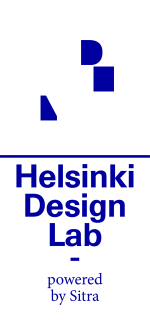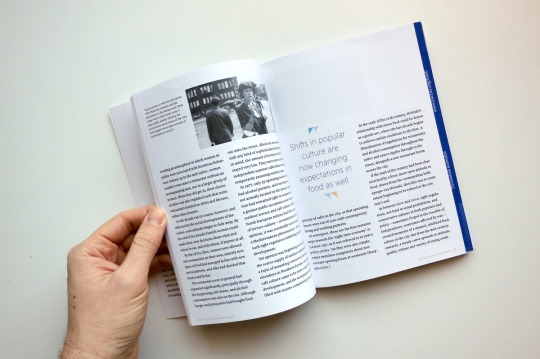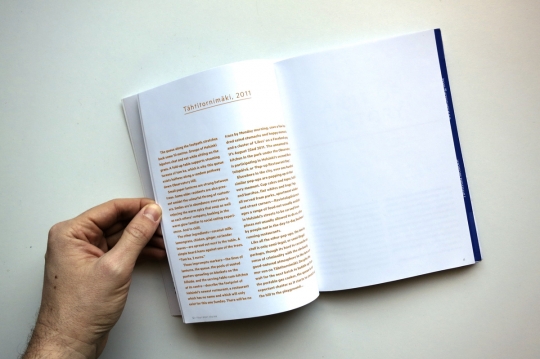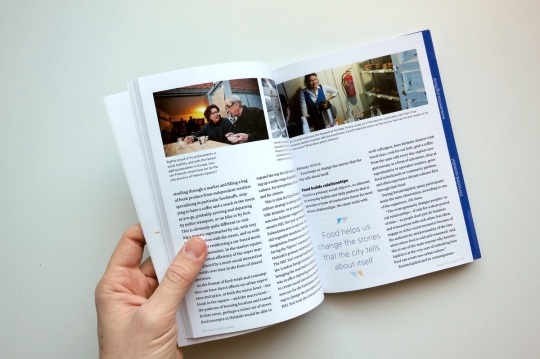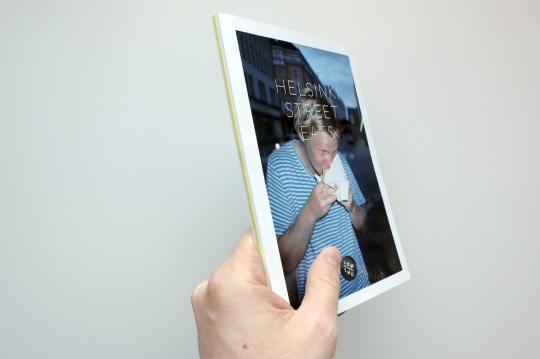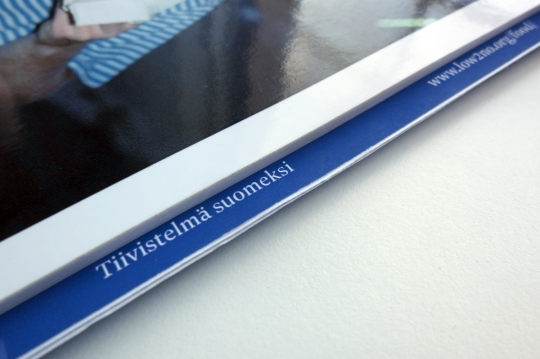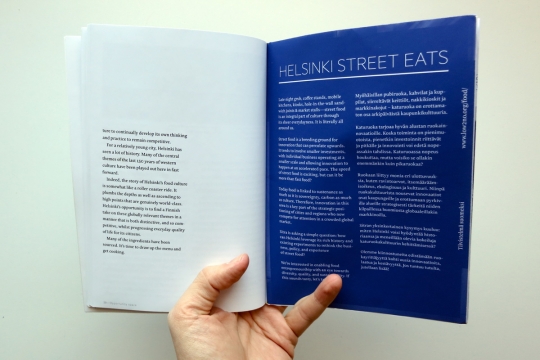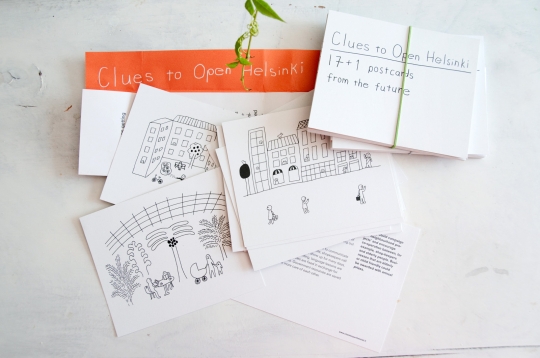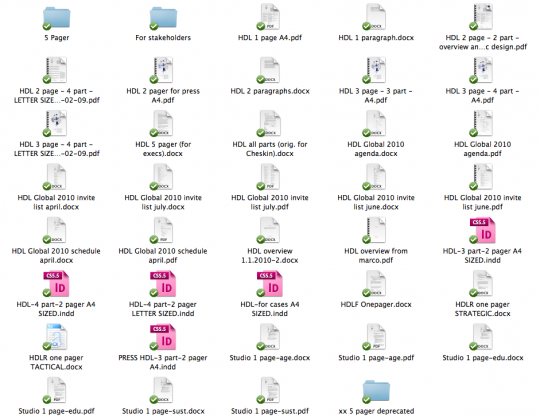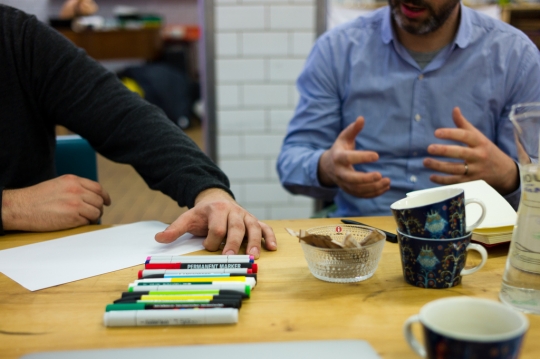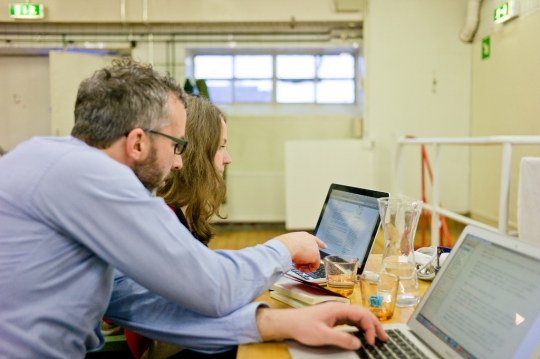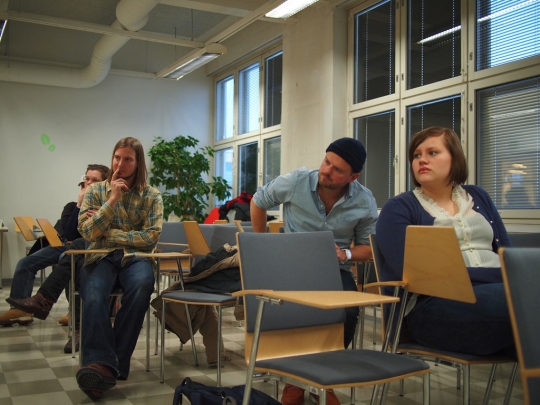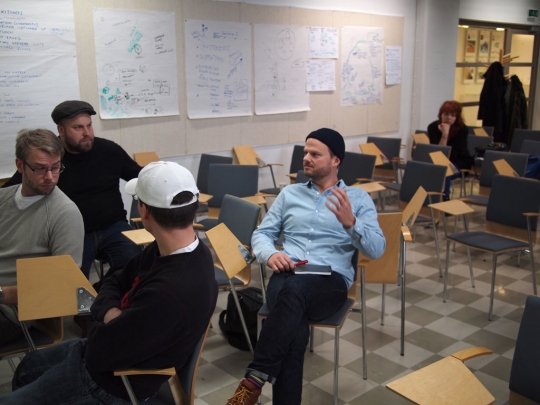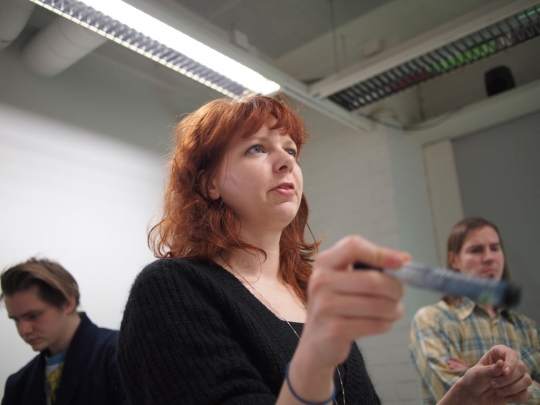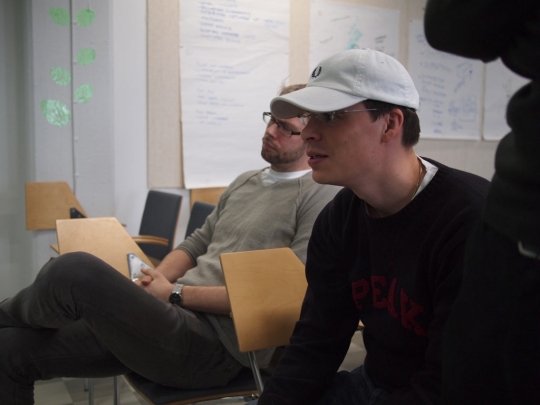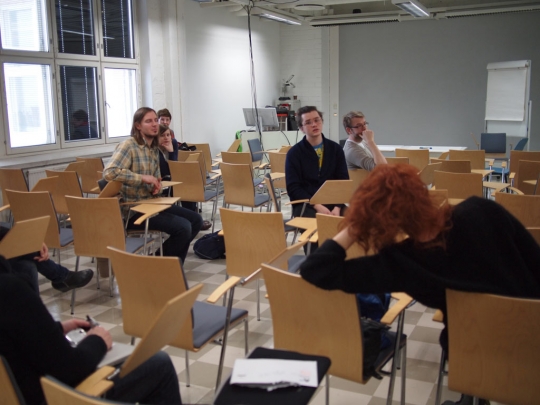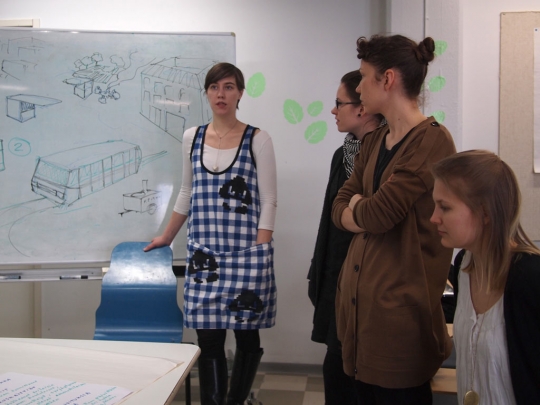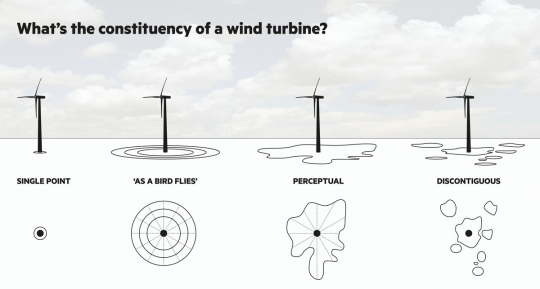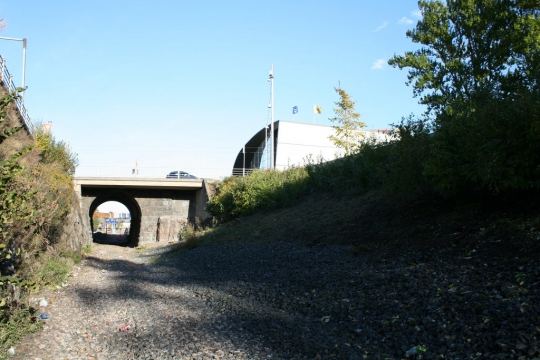Helsinki Design Lab helps government leaders see the "architecture of problems." We assist decision-makers to view challenges from a big-picture perspective, and provide guidance toward more complete solutions that consider all aspects of a problem. Our mission is to advance this way of working—we call it strategic design.
Posts tagged with "How-To" contain reflections on designing, organizing, and operating the HDL Studios. This post was originally drafted as part of our In Studio book but was cut and has been lingering in draft mode ever since. As we're now spending more helping other public sector organizations boot up internal design capabilities the topic became relevant again. So here we go!
—
In a previous post we talked about Transferring Knowledge with regards to stakeholders who are outside of your organization. In this post I'd like to talk about the flip side of that: how knowledge is transferred internally. Or maybe it's more basic. How does one build commitment within their own organization?
A bit of explanation is due. Strategic design was a new thing at Sitra when we began preparing for HDL 2010. In fact, before Marco came to Sitra as the Director of Strategic Design the position didn't exist. For us the stakes of the studio were double—they had to serve a need for the external stakeholders while also helping to demonstrate to our colleagues here at Sitra what design is, what it looks like, and what benefits a design process can yield. The worst thing that could happen was that we end up as an 'internal service bureau,' offering turnkey services to disinterested 'clients.'
In fleshing out this aspect of the Studios we took a slightly oddball approach and sought to build internal partnerships that would yield financial (€€€), social (networks), and human capital (know-how). In other words, we thought of ourselves as a startup looking for seed funding within the broader umbrella of Sitra.
Financial capital
Money is always useful when beginning a project, but the motivations for seeking internal 'investment' go a bit deeper—after all, this is a question of moving money around internal accounting buckets, so it's mostly an imagined barrier. Money may be a flawed symbol of commitment, but it's a convenient one.
The reason we asked that our partners in the Public Leadership and Management Programme and the Energy Programmes to contribute to HDL studio budget was to make our shared commitment more tangible in the early phases of the project, when design was still mostly a magical black box for most of Sitra. It was a leap of faith that we're very thankful for!
Formalizing the partnership by re-allocating funds served as a reminder of the shared vision that we were developing. In a public organization like Sitra the accounting system is robust, requiring diligent structuring and sign offs, so we turned this into an asset by using the 'gatekeeping' nature of the accounting system as a way to regularly revisit our shared commitment both verbally and in writing.
Social Capital
With a bit of skin in the game, our internal partners also had increased incentive to be personally invested in the Studios. The first evidence of this deeper level of interest came through the sharing of networks. For each of the studios we conducted extensive research to create the challenge briefing, organized a day of field trips for the studio members, and brought a handful of guest speakers. This amounted to a significant network-building effort, especially considering that our knowledge and connections in the areas of education and ageing were limited at the outset.
We were obsessive about quality because the studio was limited to a one week on-the-ground window of opportunity, there wasn't a single minute to waste. In practical terms this translated to thorough vetting of all speakers and guests under consideration for the Studios. Our internal partnerships were instrumental in helping build long lists of possible studio members and guests, as well as making personal introductions and helping start those relationships off on the right foot.
In return, the promise that we made was to help the programmes develop their own networks. Since we were out in the field talking to people on a more or less daily basis, it was easy for Marco and I to keep in mind the needs of the programmes and make connections where they seemed valuable.
Looking back over the invite lists for each of the studios, it's clear that each of them is the result of a deep meshing of the various personal and professional networks within Sitra—and richer because of it. By using the broader networks as the basis for our recruiting we were able to introduce productive overlaps between studio members, guests, and others involved which would not have been possible with our own HDL network alone.
Human capital
Having the partner programmes on board with the Studios added resilience during crunch points when we had acute needs for extra help. For instance, being able to get an extra pair of eyeballs to review the challenge briefings at various stages of their creation was very helpful. This also served as an opportunity for our partners to be personally involved in the process, seeing for themselves how key parts of the design process are developed and fine tuned, and hopefully to take some of that experience back to their own teams. There's a delicate balance to be struck between asking too little of your partners and overwhelming them with requests. At the moment we don't have any grand insights into what that point is, other than to say you'll see it on the face of your coworkers when you're about to topple the balance!
Being Realistic
Given that there was no precedent for design within the organization, the level of support and trust that has been afforded to HDL within Sitra is remarkable. Starting from scratch, we knew that the Studios would be a good opportunity to help our leadership see for themselves what strategic design is all about, but we also knew that we had to be realistic about how much of their time we could hog. Everyone has packed schedules, and for top leadership that's doubly so.
For many reasons we are averse to memos and reports. Particularly when dealing with a topic such as strategic design, which can be quite abstract, we knew from the start that it's more productive to have conversations than put things immediately into writing. As much as possible we tried to create opportunities for in-house leadership to visit with Studio, to see it for themselves, and to hear from the Studio members what the experience was like.
On the other hand, we also had to be realistic. What's the minimal involvement that would be useful? Two or three brief visits each from a couple key individuals over the course of the entire Studio experience was effective in generating a deeper level of in-house understanding. As much as possible, we encouraged these visits to occur during active times (like the final jury discussions) to maximize their impact.
Making (and taking) Time
Having built strategic design at Sitra and the HDL Studios with a combination of financial, social, and human capital on a hunch that all three would be needed, this combo only becomes more critical the longer we work on these issues. As Sitra has now been practicing strategic design for coming on four years, the deep importance of strong partnerships—internal and external—can only be underscored.
Perhaps the reason for this is quite simple: partnerships take time. The longer we spent working with our internal partners the more we see saw strategic design taking root within Sitra. Patience and persistence might be the most important kinds of capital we have.
Logistics were on the docket this week. Amongst other things, we've been finalizing some hirings that have been in the pipeline for a long while and laying down a bit of structure for the three month run-up to summer. This includes a fair bit of calendaring to make sure that our various travel schedules are well coordinated, especially in light of the new interns joining us and various events in town, such as the DMI conference which Marco is co-chairing.
Are you an aspiring strategic designer looking for a place to apply your talents? This week we officially launched our second Design Exchange placement opportunity with the Helsinki department of Social Services. Apply here if you're interested, and please help us spread the word if you know someone who would be a good fit.
On the subject of interns, Mr. Seungho Lee holds the honor of being the very first HDL intern and he has recently completed a publication entitled Beef Finland 2012 as part of his Masters of Arts coursework at Aalto University. Seungho has focused on constructing a briefing to frame the question of production and consumption of beef in Finland (as you may suspect from the title). We're glad to see that his time with us contributed to his own work and thinking, and the newspaper is a good read.
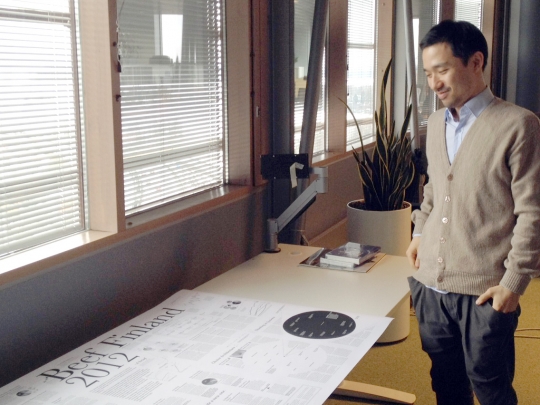
Seungho stopped by to drop off some copies of his thesis newspaper.
Our own focus on food has been a bit dormant this week. Glancing at the revision history of a shared one-pager on our Basecamp site it looks like there have only been a few nibbles since the last workshop. It's to be expected, though, and our next internal workshop on the food work is coming up this week. Workshop one was about putting some brackets around the concept, audience, content, and timeline for the programme we're looking to develop and it ended with a draft one pager. Workshop two will take the one-pager as a starting point and expand it into draft project plan.
We're taking a slightly different tack with Brickstarter. Because of the relatively high pace of global innovation around Brickstarter-like topics at the moment, we've decided to play that project out in public by sharing our research and eventually product development on the blog. Dan and I ended Week 159 by noting some immediate to-dos. Top of the list from a product design perspective: personas and use cases. We also continue to scour the countryside for appropriate NIMBY-potential case studies that we can sketch in code with.
Kali and I met with a gentleman who has been researching wind energy in Finland which was helpful in identifying further avenues for sourcing potential case studies. We also spent some time with Neste Oil in Porvoo, quizzing them about how they interact with the communities who live near their two Finnish refineries and are understandably curious about what's going on with their rather industrial neighbor. On the other end of the scale, we also had a moment to visit a group of designers, artists, and concerned citizens who are developing ideas for Baana, the sunken rail line that Dan wrote about previously.
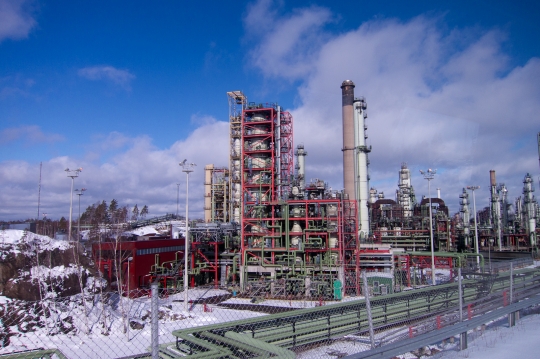
A small corner of Neste's 1300 hectares in Porvoo.
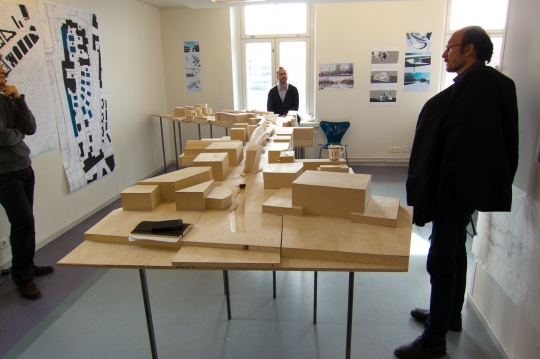
The atelier of a group developing an expanded field of options for the Baana site.
Developing Brickstarter in public is also a way for us to demonstrate what a project-oriented way of working looks, feels, and sounds like as Sitra continues to move towards a new operational model. In that light, we're taking a play from our colleague Karoliina Luoto who managed the development of the newish Sitra.fi website in a very public way via a separate project blog.
As part of our internal development work we've also been coordinating the renovation of one of the floors of the Sitra tower. When it's completed later this year, the new space will give us more project spaces, which we desperately need. And what's a project space, you ask? It starts with a large table and as much whiteboard space as you can muster. Beyond that we're looking for a space which invites ad-hoc meetings, one that communicates a casual professionalism, and one can be flexible with the ebb and flow of work through our organization. We'll dedicate more time to these questions in a future post when there's something more to show!
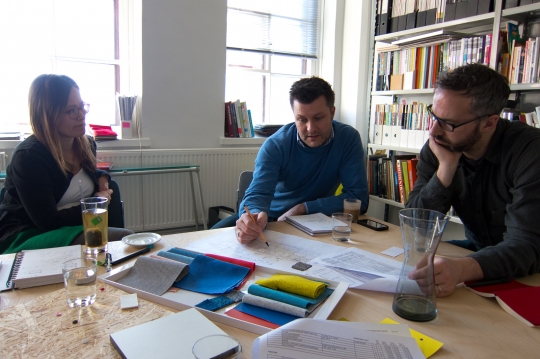
Helka and Jukka from KOKO3 lead us through their proposal for the new floor at Sitra.
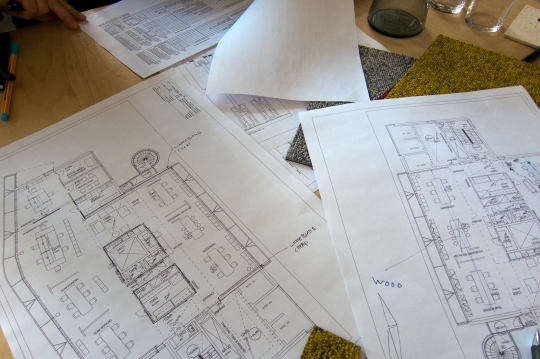
The switch to open floors will be a big step for Sitra, but people have been courageous so far in considering the change.
Technically it was two weeks ago, but since we're on the topic of offices, recently I had the pleasure of visiting Marimekko whose entire operation—design, sales, marketing, production—are housed in one building and have been since the 1960s. Doing so allows them exactly the kind of effects we're seeking to maximize: collaboration, flexibility, and focus.
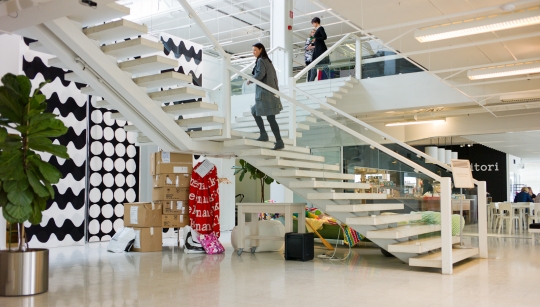
A grand stair in the entrance acts as a collection point for chance encounters as people come and go.
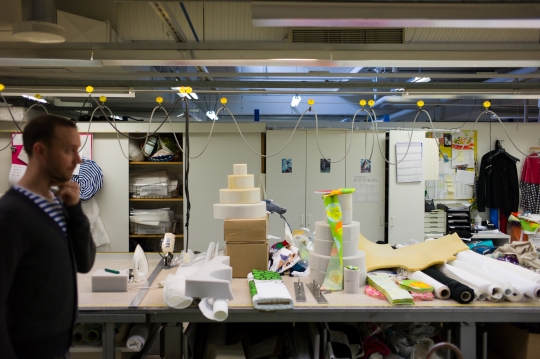
Jeremiah, one of our design leads from the Synergize Finland Studios, was kind enough to give me a tour of the operation.
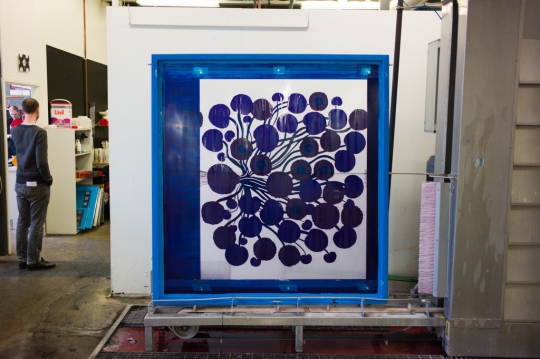
As you might expect from the Marimekko factory, it's filled with delights.
Embedded in our internal efforts is a transition towards a Sitra culture that is more explicit about what we do, how we do it, and why we do it. With that in mind we enjoyed the ten Design Principles of the UK's Government Digital Service both for its content (many of the same rules apply in the Strategic Design Unit) and its clear and simple presentation.
Today we're also curious, are you as obsessed with Borgen as our whole team has been lately?
We are very excited to announce that the Design Exchange Programme is now seeking applicants for our second placement opportunity. This time the selected candidate will work in the Helsinki Department of Social Services for a year, helping to develop a culture of service design.
For more details, see the job posting.
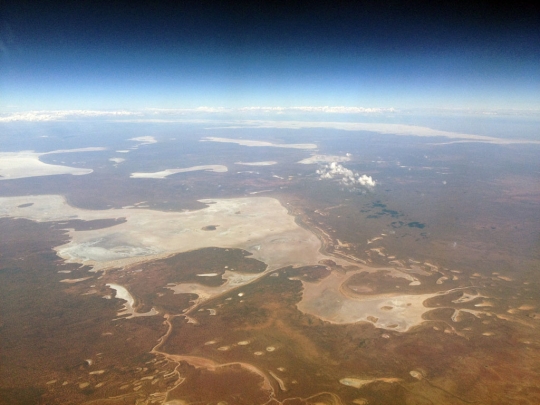
Flying over Lake Eyre, northerly out of Adelaide.
This week, the weeknote is really brought to you by Adelaide and Melbourne Design Lab, rather than Helsinki Design Lab. I've been in Australia all week, and have only the vaguest ideas as to what's been happening back home! Justin's in town, which is good, and he, Marco and Bryan have been knee-deep in our internal organisational strategy work, as well as keeping our Low2No food projects ticking over.
One thing; our Design Exchange operative #1 - Sara, embedded at City of Lahti - has got a new site live for the 'Radanvarsi' urban development around the train station in Lahti. The site is for the project competition, and citizen participation around the development in general. It's all slightly beta - of course - but will begin filling up from now on. (PS. Note, we're looking for another strategic designer in this progreamme, as part of Helsinki Department of Social Services - apply here.)
But as the team were slaving over a hot organisational strategy stove (?!) in a Helsinki which had momentarily turned its back on spring, I was in sunny - very sunny - Adelaide.
I was there for a quarterly meeting of the Integrated Design Commission Advisory Board (more info on the board here). The IDC, led by Commissioner Tim Horton, and part of the office of South Australian Government Architect Ben Hewett, is one of the most interesting design interventions in Australia. It's also one of the few other organisations worldwide also working as a strategic design capacity for core public institutions.
It grew directly from the work of one of Adelaide's Thinkers in Residence, architect Prof Laura Lee, and sits right at the heart of government - part of the Department of Premier and Cabinet. It's charged with aligning design disciplines, industries and efforts across the state. In practice, this means focusing initially on planning, architecture, urban design and other built environment issues - but given the state's manufacturing history, this also means some interesting incursions into industrial design, via prefabricated housing. In this respect, it's a little different to our mission - though we're often covering similar ground. But their work essentially concerns gluing back together core disciplines and perspectives that our societies have allowed to wander too far apart; which is certainly developing a similarly holistic view to that pursued by our Studio process.
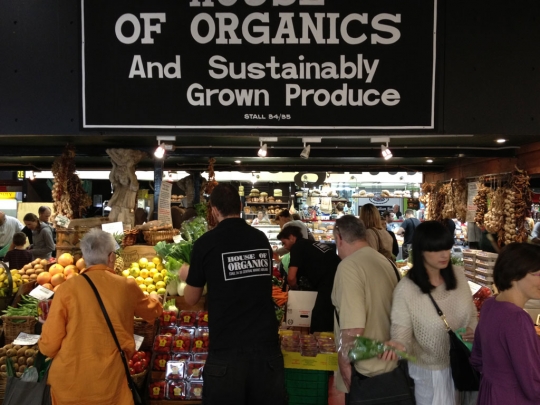
Adelaide's excellent Central Market indicates the value of local, organic everyday food.
(Tim and I often reflect on the ideal proxmity from seat of power, for a strategic design function. You need to be close to effect genuine change, clearly, but not too close as to be a political football. The IDC team seem to have it about right; see also Ben's work as Government Architect, and the major announcement of a City Design Review Panel, which was happening last week; a huge step forward to get qualitative assessment at all stages of the urban development process. As Planning Minister John Rau said of the announcement "If we are going to encourage more South Australians to live in the city, then excellent design is critical.")
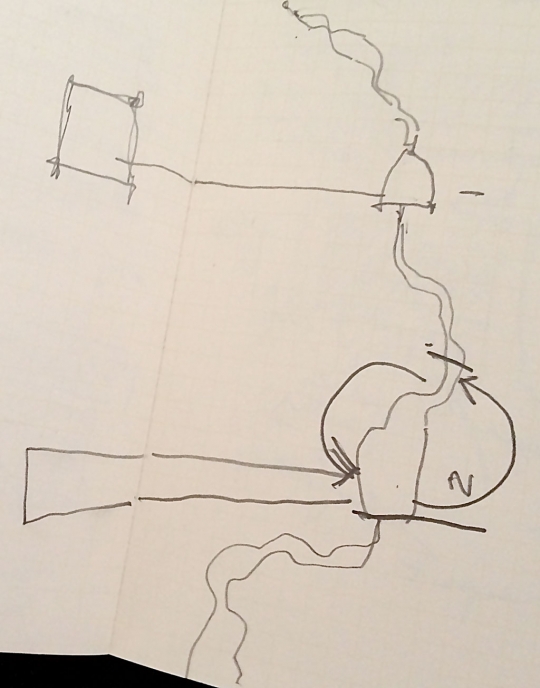
Tim Horton's sketch of River Torrens system, scribbled in my notebook over lunch
Amongst other projects, the IDC team are at the heart of the 5000+ project, which is intended to be a replicable model for citizen participation in urban planning, or more broadly, discussions as to what Adelaide is for. This is particularly interesting as regards Brickstarter and Low2No, but worth checking out in general. IDC have even successfully taken the HDL Studio format into their work - which is exactly what we hope happens by publishing blueprints in such detail - which builds on several conversations we had when I was originally in Australia, pre-Sitra.
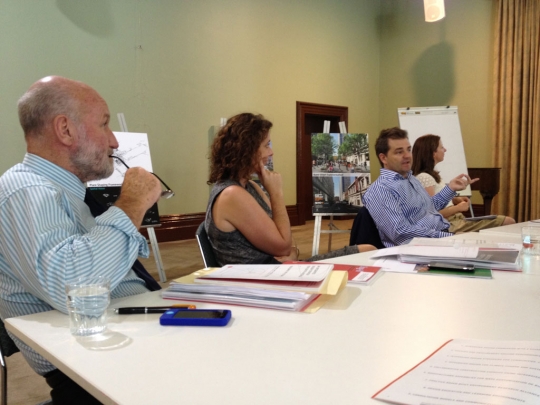
Advisory Board: Prof, Graeme Hugo, Associate Prof. Joanne Cys, Tim Horton, Jane Crosby

Advisory Board: Ben Hewett, John Denton, Dr Elizabeth Farrelly
I think Adelaide is a great little city, as it happens ("little" in comparison to Sydney and Melbourne, both of whom tend to look down their noses at it, as is the way of such things. Adelaide, like Helsinki, is a good population size for a city; it's the distribution that needs a little work.)
Like most Australian cities, it's slowly beginning to develop a sense of its own urbanity, despite a good half-century of suburb-dominated misteps, and that is good to see. The work of the IDC, and the several other initiatives in the city, will be key to ensuring a vibrant and productive urbanism emerges. It was great to see evidence of 'emergent' innovation filling the numerous gaps left over by 20th century urban policies, such as this fabulous pop-up lobster taco stall and winery, occupying a vacant parking lot. From totally dead gravelled non-space to fine lobster tacos and some of the world's best wine, and 'one-in-one-out' by 7pm on a warm Friday night. (Please excuse the dark mobile phone video, but it captures something of the mood.)
One paper the IDC delivered to the board was SGS Economics' review of the economic impact of the Renew Newcastle intiative, revealing an extraordinary 10:1 multiplier effect of Renew Newcastle, as well as other 'shared value returns' on investment. (Though when assessing these 'economic impact of cultural initiative' papers, I'm always reminded of my friend Justin O'Connor's note that no-one ever asks for a 'cultural impact of economics' study, which would surely reveal the opposite of a multipler; a divider, even?).
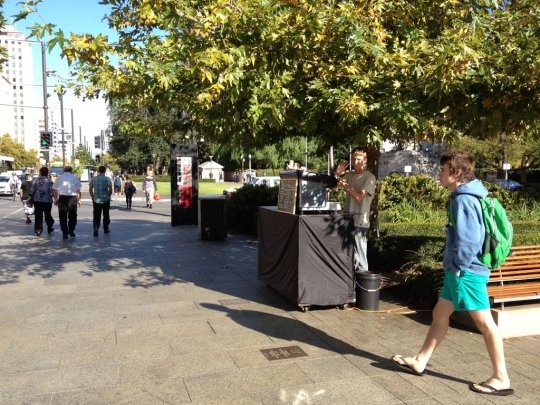
Pop-up coffee stall, part of a trial testing looser regulatory approaches to licensing in the city.
And before our meeting in Adelaide, I caught up with Marcus Westbury in Melbourne. Marcus created the Renew initiative - first in Newcastle, NSW - and Renew Australia is now based in a good retrofit of an industrial unit in Brunswick, Melbourne. It was great to catch up with Marcus; he and I worked together on The Edge in Brisbane, and he's such an original thinker (and doer) in terms of genuinely shaping cities. Notes to follow on that chat over on our Brickstarter project site. (There's a Renew Adelaide, as it happens.)

My diagram of Renew Newcastle looking for gaps in 'dark matter', during chat with Marcus Westbury
I was in Melbourne for a crazy 36 hours courtesy of the University of Melbourne School of Design, and particularly the architecture department. I met some very bright urban design masters students for lunch, gave a public lecture (thanks to all who turned up; Twitter was pretty effective at getting a few hundred in a room with not much notice.) Ditto a lecture at Arup Melbourne the following lunchtime, part of the Innovation Forum series now curated by Stuart Candy.
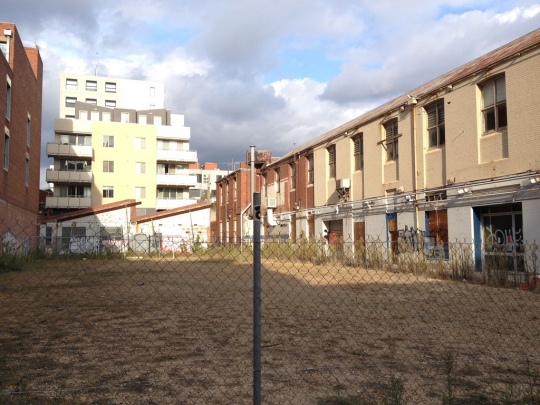
Brickstarter-friendly site, 500m south of University of Melbourne architecture department.
Back to Adelaide, and meetings with TACSI's Brenton Caffin, around where might 5000+ go next, and IDC again, advising on how to handle discussion around smart city strategies, before an incredibly useful phone conversation with City of Sydney about their exemplary recent tender for food trucks.
It was great to hear about their approach, which Helsinki - and many other cities, for that matter - can learn much from. We're trying to broaden the conversation around street food here in Helsinki - including with the City, as previously noted - and these kind of case studies from other cities are often very important in terms of shaping opinions. Again, more details soon, as this one warrants a post of its own over at Low2No.
Week 157, and a touch of 158 if we're being honest, was mostly about getting things out the door. Almost by coincidence, we finally launched new websites for the Design Exchange Programme and Brickstarter, made some cosmetic tweaks to this very website, and published a 98 page book on street food in Helsinki. It was a lot, but a long time coming!
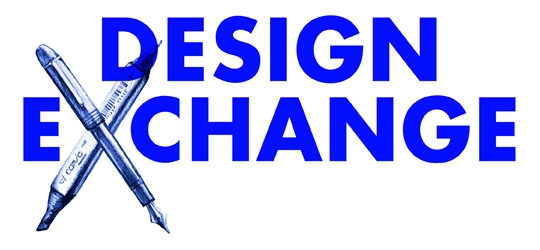
The Design Exchange (DEP) website is where you can track the progress of our embedded designers. The goal of the DEP is to move one step closer to policy by design. This entails enhancing the capabilities of the public sector: new abilities to frame problems, iterate solutions, seek feedback, and communicate clearly.
There's a quick intro to the programme and I've also shared a bit of the background of how the DEP came to be. When I look through our files on that topic, they stretch back to late July 2010. Although we had discussed it internally as a 'what-if', the concept first appeared in the Clues cards (especially the one about Tailor Made Municipal Services) and came up again during the Ageing Studio discussions.
Perhaps it's no surprise that Petri Lehto, a member of the Ageing Studio, has been one of the driving forces behind bringing the DEP to life and we're grateful for his collaboration, as well as that of the many other people involved at our partner organizations.
At the moment we have only one placement up and running, with Sara Ikävalko working at the city of Lahti to develop a new participatory process for a competition they are hosting there.
We're getting closer to having more placement opportunities open. When that happens we'll advertise them here on the HDL site as well as the Design Exchange site, so be sure to check back if you're a Finnish-speaking designer interested in working in the public sector.
In a nice twist of symmetrical history, the same week that we launch a project which took cues and clues from friends at MindLab, saw another group, the MaRS Discovery District in Toronto, looking to HDL for advice on their own explorations of a new lab. The report is quite informative, and we're happy to be a reference as they look for the best way to put "complexity, networked collaboration and design" to good use.
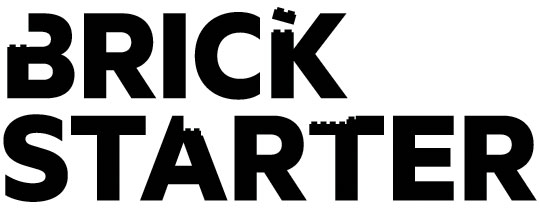
Next up was Brickstarter, a project we're developing that seeks ways to turn NIMBY into YIMBY (yes in my backyard). How might we reorient community action from no full-stop to "no, but how about..." or even "I'd really like...!"
As Dan explains in the introductory blog post, our thinking and work on Brickstarter is beginning to pick up, so we needed a place to bind these thoughts together into a big ball of ideas. The Brickstarter blog is a mix of notes from our field trips, quick dives into terms and concepts, and eventually some case study research. Some themes:
Community decision-making; new engagement tools; long-term investment in sustainable infrastructure; participation and representation; prototyping as research, iteration as planning; user-centred redesign of governance and legislation; different relationships between citizens, businesses and governance; potentially even prototypes of political systems...
To give you a concrete example, What's different about this shady courtyard on Tarkk'ampujankatu...
And this one on Tehtaankatu...?
It's hard to see with the trees full of life in the summer, but the biggest difference between these two courtyards is that features a garden and the other a parking lot. Otherwise they're about the same size, in the same neighborhood, and have the same solar orientation. They're essetially the same from a contextual point of view, yet one group of owners has decided to use the space for parking and another for a garden.
With Brickstarter we are trying to understand how these decisions get made, and eventually to developing a platform that enables them to be made with greater levels of participation. Why? Because we think that new tools will allow communities to make decisions like this with higher social equity, in a less devisive manner than typical NIMBY dynamics, and with heightened attention to opportunities that consider the long-term.
Recently there has been an uptick of interest in 'meanwhile' or temporary usage of sites. We see this as positive development, and in a certain way Brickstarter is our attempt to look at how the verve of these grassroots efforts can be grafted onto the institutions that shape everyday life. One of our hypotheses at the moment is that there is a missing interface to government. What would that look like? Figuring it out will require our usual dip into strategy, but it’s likely to also involve building product(s).
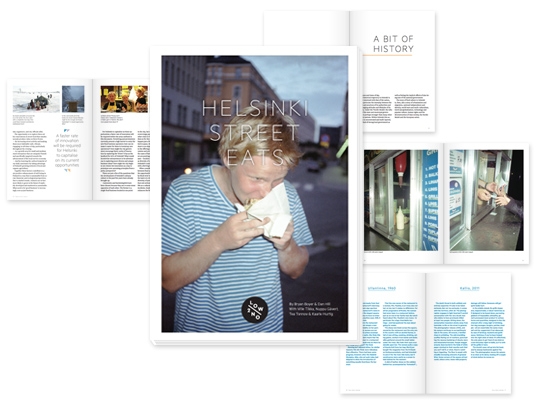
Helsinki Street Eats, the book which was our third release this week, has similar ambitions. We wrote the book to begin asking questions about the extremely positive developments of Ravintolapäivä and the Camionette. On it’s own a festival like Ravintolapäivä is a nice urban experience that happens a few days a year, but the next morning it's gone without a trace. With a bit of work on the dark matter, these experiments can be looked at anew as prototypes of a future regulatory, business, and social context.
The book was a way to crack open that question, and now we’re slowly but surely sketching out a way for those ideas to take root. If you’re the type who is into books and publications, I wrote a post about the ways we experimented with print-on-demand in the production of Helsinki Street Eats.
Otherwise there’s not much to say beyond get your copy here!
Beyond these launches, we're still working on internal projects. Parts of that effort is about to wind up soon, which is good because we have our hands full at the moment—as you can probably tell!
This post is part Low2No project update and part design how-to delving into simple customization of the Print On Demand books as a format. First, the update. Low2No is about creating pathways for our current, high carbon economy and culture to transition to a neutral carbon footprint. An important aspect of that is what and how we eat.
Especially for a place with the northern climate and high meat & dairy consumption habits of Finland, food production and consumption are key concerns when you're interested in carbon.

Helsinki Street Eats, a new book about street food as a vehicle for innovation
We've been looking at street eats as an example of "everyday food", the stuff that's close at hand such as late night snacks, kiosks, bakeries, food trucks, and the like. In fact, let's take a slightly modified excerpt from the Low2No site:
Street food describes systems of everyday life. In its sheer everydayness we discover attitudes to public space, cultural diversity, health, regulation and governance, our habits and rituals, logistics and waste, and more. What we find most interesting is the intersection of all of these aspects: how they come to a balance and tenor that enables and encourages specific kind of outcomes in a specific place and time.
Street food can be an integral part of our public life, our civic spaces, our streets, our neighbourhoods. Street food can help us articulate our own culture, as well as enriching it by absorbing diverse influences. And it can enable innovation at an accelerated pace by offering a lower-risk environment for experimentation.
Street food can do all of these things, but it doesn't necessarily.
This book is an attempt to unpack what's working and what isn't in Helsinki, and sketch out some trajectories as to where it could go next.
The full 98 page book is available for download, and you will also find links on that page to buy a printed copy from Lulu.com, a print-on-demand publishing service.
Readers of this blog may already know that we're a bit obsessed with formats. We are given to nerding out on the minutiae of publishing online and in print, which is probably no surprise since as a team we have direct experience in producing magazines, newspapers, books, radio, websites, buildings, and various other media. (Aside: this makes us an unusual public sector team, to say the least.)
It's nice to go all-in on a book and obsess over every tiny detail from writing to printing, as we did the In Studio: Recipes for Systemic Change. With this most recent publication on Street Food we were interested in exploring a format that would be more ephemeral. One that could change and evolve as our work on the topic does; a paper document that could have different version numbers; and one that felt easier and more casual. We also wanted to self-service distribution model.
Print-on-demand seemed to fit the bill, offering flexibility along most of those axes, but print-on-demand books tend to be… dull. The easiness of the format shines through. How could a print-on-demand book be a bit more special—could we find some relish to serve it up with?
People have been hacking print-on-demand to do some interesting stuff, but it seems to be all on the software side. We wanted to hack the print in print-on-demand. Lulu hacking.
Surprisingly, there still does not seem to be an option that surpasses Lulu. I say surprisingly because the Lulu experience is quite terrible. Their tools are limited and the workflow is awkward. As one small example, you can set the country of publication only after you've published a book. According to Lulu all published books apparently come from the United States, at least at first. Blurb is another popular print-on-demand service and their quality is higher, but their document sizes are limited and it's mostly for photo books.
Over the past months Dan and I sketched lots of (sometimes ridiculous) ideas, including at one point the thought of laser cutting Lulu books into new shapes. Stepping back from that precipice, we've settled on a basic combination: a full-color 98 page print-on-demand book paired with an offset print fold-out poster, all bound together with a rubber band.
The books come straight from Lulu and the rubber bands can be found at any office supply shop and countless online sources so that only leaves the poster for us to source through a traditional print house.
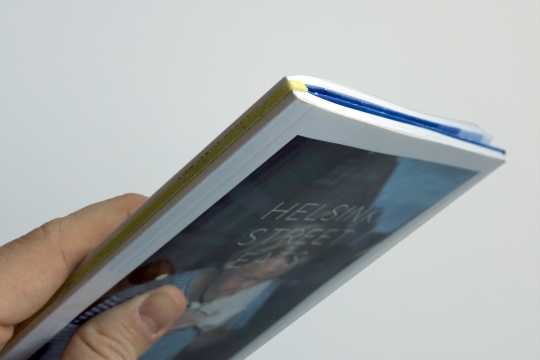
Usually the spine of a print-on-demand book is a sore point because the alignment can be unpredictable. The rubber band nicely obscures alignment errors.
The poster is designed to fold down into A5 format so that it fits neatly within the book. Right now we're waiting for the actual posters to come back from the print house, but they will be printed on 60gsm paper which means they're a good 25% thinner than standard printer paper, making them easier to fold up.
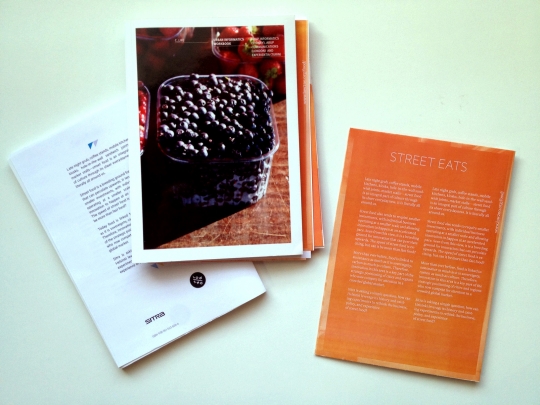
Various paper prototypes using the office printer and tape to craft posters and an old Lulu book as a stand-in.
The binding pushes the poster out a few millimeters which creates a natural 'tab'. We discovered this on accident while making a prototype, but it was a nice discovery since we wanted to have a quick way to thumb to the Finnish language summary.
When we give out copies of the book they'll come with the poster and rubber band, but if you order a copy online or download the PDF you'll find the contents of the poster included as normal pages.
Because print-on-demand does not have any setup costs or minimum print runs, we can also offer the same book in multiple flavors. As we started working on the cover it was hard to settle on a single image, so we decided to let the user decide. There are four copies of the book available for download/print. All of the contents are the same, but you get to pick your own cover. My favorite features a scene of Kauppatori from 1901. What's yours?
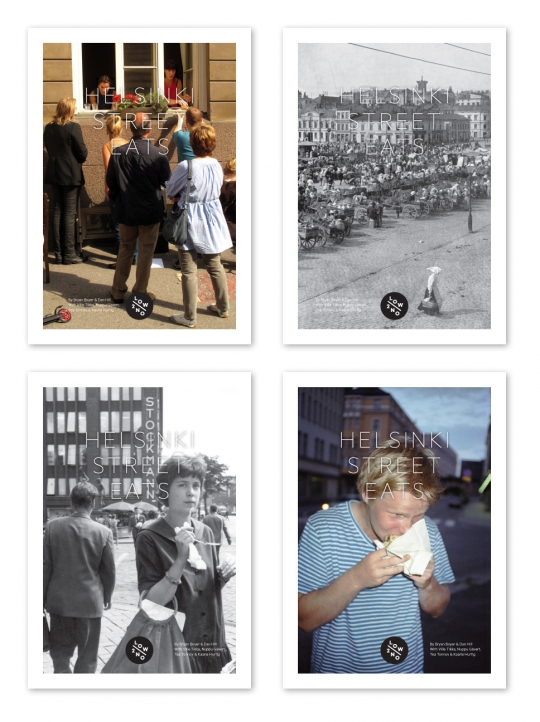
Clockwise from top left: Ravintolapäivä August 21, 2011; 'The Great Saturday Market' at Kauppatori in 1901; Jaskan Grilli in August, 2011; Outside Stockmann in 1959.
Although the writing and research for this project has been on slow burn for about nine months now, the production of the book was pretty quick. Dan and I did all of the work in house, tossing files back and forth with occasional but insightful comments from Marco and Justin. One of the positive side effects of taking longer than expected to deliver this project was the opportunity to shoot extra photos around town, so it's richly illustrated.
The larger team included Ville and Nuppu of WeVolve on interviews and research; an investigation into the supply chain and geography of a typical hodari (hotdog) by Aalto University student Tea Tonnov; photography by the indefatigable Kaarle Hurtig; and tips and ciritique from too many people to mention.
Hope you enjoy! Hyvää ruokaa!
That pile of snow from last week? Still there. And not only that, it's snowing as I type, so the thing is growing.
Dan remarked the other day that during this time of year it feels like everyone is booting up new projects. Could the surge be detected in the number of domain name registrations? We've booked one this week, with another to come once we settle on a name for it. Buying a domain name is a good inflection point. It means the project has solidified enough to be developed in public.
They come and they go. The domain name for a quick project from a couple years ago will be expiring soon, so we've moved it to this website for posterity. The permanent home for our Clues to Open Helsinki is now in the HDL dossiers. The grunt work of moving the project from one website to another was a nice opportunity to revisit the work and be reminded of the extent to which many of our current interests were there in nascent form. Food? Check. Community decision making? Yup. Design exchange? Sure enough!
During the last couple months we have been slowly building up two projects about food and community decision making, and this week they took the leap from more or less fuzzy interest areas to specific proposals. We forced ourselves to sit down and draft a one page description for each project.
Despite the awkward term—and please let us know if you have something better—we like one pagers around here because they are a simple way to bring a level of rigor in one's thinking: big ideas, small page. Here's how we do it.
Working simultaneously in Google Docs or huddled around a Word document on a laptop, we take turns drafting sentences, phrases, and fragments. At an early stage the one pager is mostly about why and what, and the who, how, and when to be covered by a cursory sentence. Or left out for the moment.
It's hard to resist the urge to drop the document into InDesign and start fiddling with layouts and font sizes to make room for more words on the page, but point of writing the one pager is to work within rigid boundaries and take advantage of the fact that the format forces you to make tough decisions. To really test yourself, try using a bullet list or two. If you're as allergic to corporate speak as I am, this will be a true test of your mettle.
But bullet points were invented for a reason: done right, they should be distilled versions of your main points. In our case, it's also part of writing to our audience. The kind of people who we need to read our one pagers tend to be used to, even expect to see, bullet points in the documents that glide across their desk. Dan calls this method designing, which is a tactic that all of us on the team practice innately.
By the end of HDL Global 2010 we had drafted something like 39 different versions of the one page description that went out to everyone from invitees to press people. Those all grew out of a single document, so the process left us with a family tree of explanation.
With luck, the two single page documents that we drafted this week will grow similar trees as they develop. Here's the first couple paragraphs of the current draft of our document for 'Brickstarter', a project about community decision making:
Brickstarter is a 21st century social service. It enables everyday people, using everyday technology and culture, to articulate and progress sustainable ideas about their community. Brickstarter is a platform to turn possibilities into proposals into projects.
The interface between citizens and institutions can be slow, awkward and cumbersome. For years, this was just the way things were. Yet the tools and media that people now use to orchestrate their everyday lives rapidly outstrip those used by most municipalities, ministries, and other institutions.
Brickstarter takes advantage of social media and mobile apps in order to address this disconnect, by developing a more articulate, more responsive, and more representative platform for citizens and institutions to work together.
What's missing here is an articulation of how Brickstarter connects community matters to dark matter but, you see, that's in a bullet list further down the page.
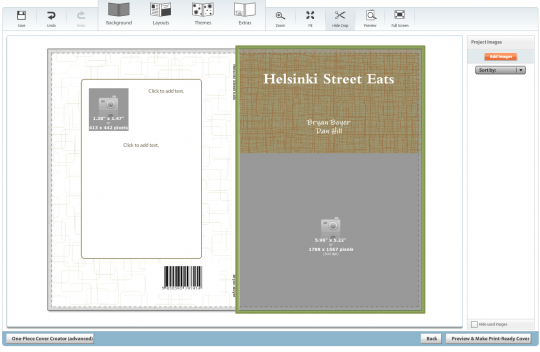
Never trust a website to design your book cover
Yes, the food booklet is still coming. In fact, that should be available for download by tomorrow. The Print on Demand Service tried to design a cover for us, but we've decided to go a different direction.
The good part of friday was spent in Kalasatama in a workshop about food entrepreurship. The session culminated in three, at at times four, people around a laptop drafting the one page description of the project that we spent the day sketching out. It's trending in the right direction and now we need to work quickly to ensure that we can meet an ambitious timeline.
Sitra has been active on food topics for a while now, most recently by supporting the development of the wholesale market with an eye towards local and organic products. That was work on the 'platform', and our upcoming efforts will be building an 'application' to take advantage of that platform.
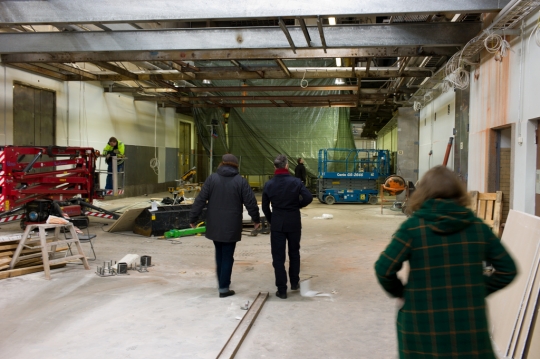
The centerpiece of the wholesale market is Kellohalli, an old butchery facility that is named for the clock on its facade. In a few months this space will be cleaned up and open to the public.
To close, an interview with Jonathan Ive in the London Evening Standard. He describes himself as "interested in being wrong." I think I like those words more than the things he and his team produce. The interview is full of good stuff, including this:
We struggle with the right words to describe the design process at Apple, but it is very much about designing and prototyping and making. When you separate those, I think the final result suffers. If something is going to be better, it is new, and if it’s new you are confronting problems and challenges you don’t have references for. To solve and address those requires a remarkable focus. There’s a sense of being inquisitive and optimistic, and you don’t see those in combination very often.
Marco declares, "winter is officially over." Mind you, this does not mean that spring has sprung, but we are expecting a week of consistently positive temperatures. Small steps.
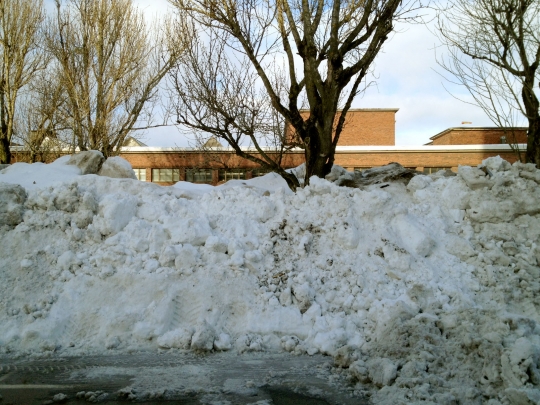
Last week this pile was snow. By the end of this week it will be slush. Yuck.
A solid heads-down week here on the home front with no travel and no major events. Just a lot of good conversations in between dispatching work across the slate of ongoing projects.
Dan and I were working on internal stuff including Sitra's portfolio management, language habits, systems, and spaces. This sounds like a lot because it is a lot. The organization has committed itself to what amounts to a rather significant transition in a short span of time and many of us across Sitra are contributing to various parts of this.
Coordination is not an issue so much as continuity. When working in different teams with disjointed schedules and at least two languages in the mix, keeping continuity through the work—and through its full duration—is the challenge.
Although we have a good store of experience in house, bits and pieces of this specific transition make it unique, something that none of us know immediately how to handle. I might even say that having to make it up as we go along has been a positive experience. As it often is!

Tuula, Jukka, and Dan hashing out the hockey cards. More on this when it's ripe for sharing.
Here in Helsinki one of the local issues is a proposal by the City that the Guggenheim be invited to build a franchise in town, at the expense of the tax payers. It's an odd proposal that has been handled in a less than open manner. A recent article in Domus has done a good job of unpicking some of the issues.
Speaking of unpicking, Rosanne Haggerty, a friend of HDL, and her organization Common Ground were profiled in recently in the Wall Street Journal Magazine. If you're not familiar with the work that Common Ground does with the homeless communities in NYC and elsewhere in the US, this article is a great introduction. You might guess from this quotation why we appreciate Rosanne's unique approach to ending homelessness: "All our problems are interconnected. Nothing’s tidy." Well put.
We ended the week by hosting a visit from the Finnish Design Management Association (FDMA), Finnish Design Business Association, and some Aalto University researchers. The latter two shared a bit of their research into the ROI of design. At the core, this effort is a tried and true way to scrape together a bit of evidence that assists designers, consultants, and managers gain the respect of the business community who are still sometimes more used to thinking of design as window dressing. The work that FDMA are doing is a local study of the perceived return on investment of design for products and services.
As we are wont to do, the boundaries of the question expanded as the group discussed what purpose the evidence is intended to serve. In a simple way, evidence is really a shortcut to trust. If that's the case, numerical evidence becomes a token that some professional cultures use to build confidence and trust. Others (like most fields of design) respond better to narratives.
Part of the group felt strongly that solid numbers are a prerequisite for design to gain respect in the C-suite. The other half of the room, perhaps slightly provoked by my suggestion that made up figures may be just as effective, argued that playing the numbers game might be useful for getting in the door, but the conversation has to move beyond, to other forms of value that are harder to measure. In our own research and conversations over the years we've heard a consistent story: numbers might convince the person sitting on the other side of the table to listen to you for a few minutes, but until they see the design process in action deep trust will likely remain out of reach.
Regardless of how one packages evidence, tokens are only ever a pointer to something larger. A large enough body of facts and figures that can convince a hardened skeptic to invest in design is unlikely to come about any time soon, simply by virtue of the overwhelmingly asymmetric pile of evidence that supports business as usual. It's business as usual, after all, until one day we wake up and things have tipped.
Just as important as the evidence is the person delivering it and the relationship that they build with the people they are pitching to, both in the moment and over time. That's about pitching, patience, and persistence.
On topics of entrepreneurship I usually turn first to Paul Graham, whose website is an excellent resource. Here's what he has to say about evidence in the context of pitching to investors:
Probably the single biggest piece of evidence, initially, will be your own confidence in [what you're doing]. You have to show you're impressed with what you've made. And I mean show, not tell. Never say "we're passionate" or "our product is great." People just ignore that—or worse, write you off as bullshitters... What you must not do is seem nervous and apologetic. If you've truly made something good, you're doing investors a favor by telling them about it. If you don't genuinely believe that, perhaps you ought to change what your company is doing. If you don't believe your startup has such promise that you'd be doing them a favor by letting them invest, why are you investing your time in it?
One of the most useful things in my experience working in startups was getting rejected. It's crushing to be turned down after putting so much effort into a pitch, but every startup has to do it dozens or even hundreds of times before someone decides to make an investment. There's nothing like having one's livelihood on the line to inspire a bit of patience.
Implicitly what I am suggesting is that designers should be more comfortable with being rejected. It always feels good to win over a skeptic with a convincing proposal, but unless it's possible to build a relationship of mutual trust the collaboration will be dead on arrival. Those relationships might result in good design work, but are they likely to yield a knockout success story that ends with a repeat client?
By no means it is easy, but we're now starting to see the returns from our own slow and persistent approach to developing meaningful relationships with various parts of the government here in Finland. Despite Sitra being a public sector organization, and already on the inside in that sense, we still had to do significant legwork to develop the right pitch, delivered to the right people, at the right moment(s). The Design Exchange Programme is one return on these efforts.
In recent years it has been remarkable to see the startup community build an open dialog around the many issues involved in establishing a technology business. The Aalto Entrepreneurship Society here in Finland is just one example. It strikes me that they understand something which often still eludes the design community: designers can be cagey about discussing ways-of-working, as if confusing the how with the what. The thing that our clients—public or private—care about most is what difference our work makes in the world. How it happens is up to us, the design community, and the more of us sharing the tricks of the trade the better off everyone will be. That's why I found our conversation on Friday so encouraging.
Good luck to FDMA, thanks for coming by, and we'll be sure to link to the results of the study here when they're available.
So it is and so it goes.
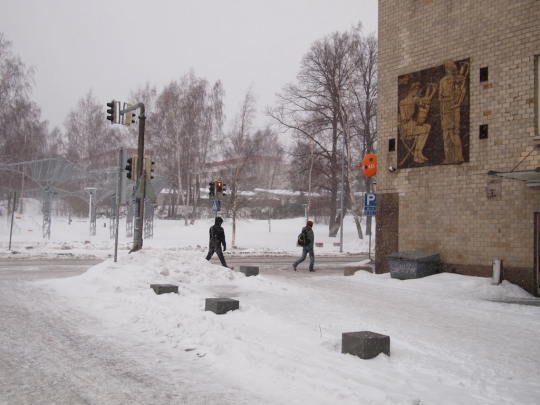
Aalto University School of Art & Design, Arabianranta campus.
A very busy but productive week, which started in a snowstorm at Aalto University, where I was running a 2-day workshop on the Master of Arts (MoA) course, with my friends and colleagues Joseph Grima of Domus in Milan and Bryan of this parish.
I've known Joseph for years (from Postopolis days), so it was nice to work together with him again. (By the way, in little over a year, Joseph has transformed the venerable Italian institution into perhaps the best design magazine around - or certainly up there with Eye and Idea, at least - so Domus is certainly worth checking out, if you haven't seen it recently.)
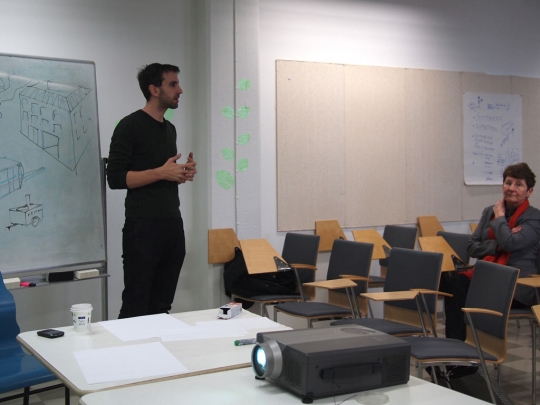
Joseph introducing the workshop.
Our workshop focused on the 'everyday food' angle we've been pursuing over the last six months, and been reporting on here. The 30 or so students were from all over Aalto's design and art disciplines, and so well-suited to such a rich topic. We set the piece with the following brief:
"Design the conditions and context that might use street food as a ‘Trojan horse’ to positively transform Helsinki’s street life & use of public space, citizen engagement & diversity of entrepreneurship, carbon footprint & cultural life."
We gave the students a set of by-now familar characters, such as the Camionette food truck:
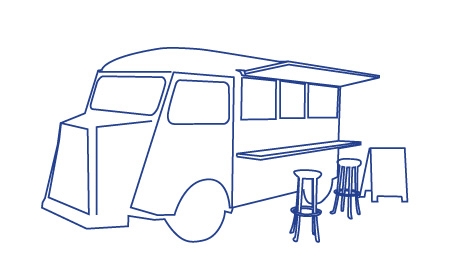
and the iconic Helsinki kioski:
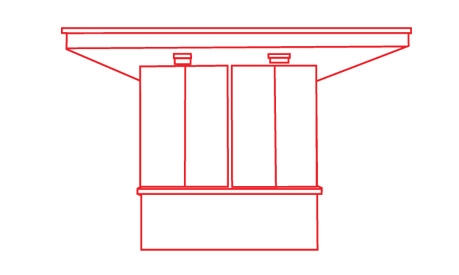
… and numerous other aspects, from wholesale markets to trams, as well as a download of history and context, which you'll be able to read for yourself, shortly.
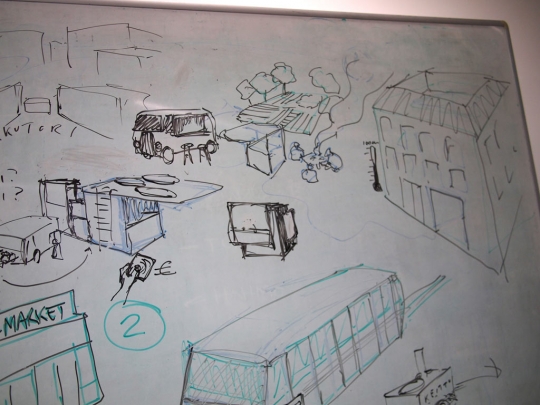
I sketched the board of 'characters' as they emerged over the two days.
They did a great job over the two days, and the last group through (we sort of exquisite corpsed our way through four groups over the two days) had the privilege/pleasure/daunting task of presenting to our panel, which included Ville Relander from City of Helsinki (see earlier entry) and Antto Melasniemi, of local culinary sensations HEL YES!, Atelje Finne, Kuurna, Putte's, and many other things.

Our fearsome-looking panel arrives.
We'll post the results shortly over at low2no.org, and look to take the work forward in some way. Thanks to Joseph, Aalto and the students for their hard work, and to Ville and Antto for their insight and energy.
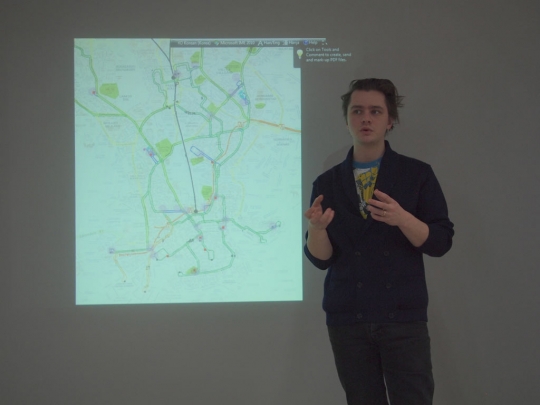
Mapping kioski, disused tramlines and public spaces.
Back to other projects, we actually bookended the week with talk of food, as we ended in discussion with Antto and Elina Forss up at Tukkutori, Kalasatama, about our various food projects. Watch that space; getting very exciting.
On our NIMBY-YIMBY or Brickstarter project (yes, we have to work on our project names), we had an excellent day of reviewing and planning, reflecting on our recent trips to Hamina and Högsåra, and what we learnt. Many things came up, with one of the more interesting conversations concerning how to measure the impact and value of shared public goods - like a wind turbine. We sketched this out on the board in different ways, before Bryan made a more elegant version of diagram-as-question.
It's all getting very interesting. We've started making a hitlist of other projects, beyond windfarms, which deal with new or old models for shared public decision-making at the community scale. Next up, a visit to the University of Helsinki's political scientists, and continued dialogue with people like Wouter Vanstiphout in Rotterdam; he of 'dark matter' and WIMBY fame.
Unrelated news: some researchers appear to have concluded that the democratic model is actually too advanced for many humans to use. Which is unfortunate. Meanwhile, in terms of other models, we note with interest that Putin is the new president of Russia.
And unrelated actiivty last week included more organisational redesign work, focusing on the creation of our new strategic 'focus areas'. Balancing 'internal' organisational design and external project activity is not easy, but we see them as connected activities i.e. to transform the way we do projects, we have to transform the organisation. And indeed vice versa.
Finally here in Helsinki, news (via Lewism, whose great images from a few years ago illustrate this section) of the plans for the long-disused sunken goods railway line that runs through much of the city centre. Known as Baana, it will connect the old ports (incl. current and future Sitra HQs at Ruoholahti and Jätkäsaari) to the centre of the city. In a time when cities worldwide are finding elegant and inspiring new uses for old spaces, it's an amazing opportunity for the city.
However, we're a little disappointed that the CIty's planning department has done little to ensure the project realises its potential. Currently, the 'design' implies a bike lane and pavement. Contemporary city making has long since left behind the idea of city planning departments that deal simply and solely with the physical aspects of infrastructure. To make such a space really sing means engaging with the productive capacity of cities, forging connections to the businesses and community groups that might provide the framework for the activity that happens at Baana. You start with this, and design the physical infrastructure as a flexible platform to support the multitude of activities that a city generates. This means planning can only work as part of a rich mix of approaches, just as with most single-discipline departments forged for another age. More successful approaches are now fundamentally human-centred; we don't make cities in order to make infrastructure, after all. It is a secondary, supporting function.
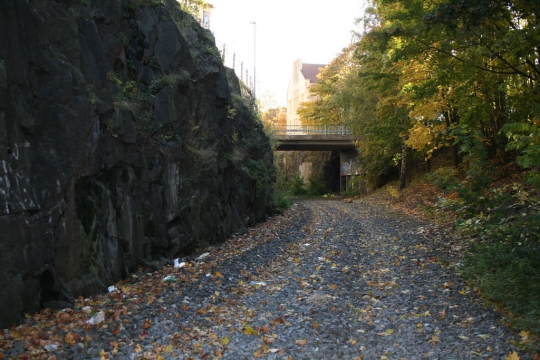
Baana, a few years back, by Lewism
In other cities, where such projects are much tougher to get off the ground - the City of Helsinki owns much of Helsinki, and has healthier finances than most - these kind of holistic, productive approaches are actually required in order to get things done, necessity being the mother of invention. Here, we often can skip all that, and go straight to the project, which is an incredible luxury (at least for the moment.)
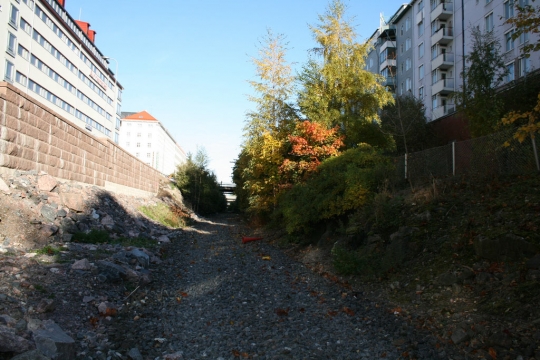
Baana a few years back, by Lewism
But with that luxury has perhaps come a little complacency. For a project that could help change the way that Helsinki works, the way it feels, the way it is, there is little attempt to make the project truly come alive, to engage with the social, cultural or economic possibilities, to communicate its potential, to open doors to new kinds of citizens, new kinds of uses, a new kind of Helsinki. Such projects have to work in the context of a holistic urban strategy, delivering multiple forms of value. (It's instructive - if unfair, due to the differences in density, local cultures and history - to compare with its inverted cousin a couple of seas away: the High Line in NYC, not least in terms of the poetry of playing with existing parasitical foliage, for instance, but more importantly, the community-led engagement, economic potential realised, diversity of activities, and quality of resolution. Equally, it's easy to critique the High Line, and the last thing one should do is copy-paste ideas from city to city. Helsinki needs to find its own response to this gift.)
It is not enough to simply make a bike path (writing as a bike rider.) And a poorly-rendered 'fly-through' of unoccupied polygons, illustrating only said bike path and a pavement, is not enough in 2012 either. We need to rethink how the city approaches such opportunities. Like any good city, Helsinki is blessed with numerous such possibilities and has had the courage to take many of them on. The challenge now is working with qualities, not quantities.
We can only assume that this is part of some broader, richer strategy for the space, focused on activity, diversity, mobility, productivity and community, rather than asphalt. If this is the case - and surely it must be? - one still has to communicate that, as part of an engaged relationship with citizens and the city, or as evidence of the strong and enriched social contract we're proud of in the Nordic region. Beyond civic responsibility, it is also the way that one begins to build participation and momentum, such that the city pours itself into Baana, flooding it with ideas and energy. Ravintolapåivå indicates what can happen you engage this city. (It's a shame the local media doesn't pick up on this either; luckily we've got new media.)
Still, it will be good to have access to it at last, and over time, the city will do what cities do to things, which is find their own use for it, to paraphrase William Gibson. It's just that things usually turn out better, quicker and richer when positioned with a little thought and care.
I started this piece noting the snowstorm in Arabia, at Aalto University (I like Helsinki; you get to say "snowstorm in Arabia" quite often). However, the weather has been spectacular, all week, and combined with the increasingly light days, is leading to a sense that we are rapidly climbing out of the state known as winter. My colleagues assure me this is a little early, however, and we may be simply getting into something known locally as 'takkatalvi' (I think that's right), or the 'rear end of winter.' This might be the wintry counterpart of what we call an 'Indian summer' in English. Not to put too fine a point on it, winter here appears to have a rather large rear end. I remain booted and suited accordingly.
The middle of February is Ski Week in Finland. I was holding down the fort while Marco, Justin, and Dan were on holiday with their families. Needless to say, it was a quiet week and a good time to do some reading. I'm currently enjoying Thinking Fast and Slow, and feeling as I read that I'm a spectator to my own behavior.
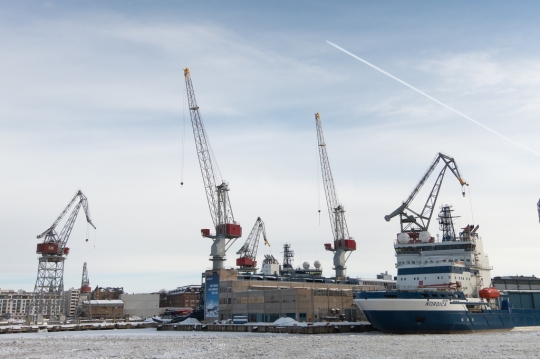
The Hietalahti shipyard was in top form last week
Also on the reading pile was a recent piece in the New Yorker that questions the usefulness of brainstorming, particularly the bit that focuses on the work of Charlan Nemeth, a professor of psychology at University of Califonia Berkeley. Psychology has been a constant source of interest over the past few months:
‘Do not criticize’ is often cited as the important instruction in brainstorming, this appears to be a counterproductive strategy. Our findings show that debate and criticism do not inhibit ideas but, rather, stimulate them relative to every other condition.” Osborn thought that imagination is inhibited by the merest hint of criticism, but Nemeth’s work and a number of other studies have demonstrated that it can thrive on conflict....
Criticism allows people to dig below the surface of the imagination and come up with collective ideas that aren’t predictable.
I like this because it brings a bit of weight to one of the working assumptions of the studio: that a mood of collegiate debate is useful in really testing ideas so that they are as robust as possible when they come out the far side of the discussion.
Other things. We're doing a second printing of the book. Mostly we need more copies because our supply is dwindling, but it also gives us a chance to correct any typos or other mistakes. Do let us know if you've spotted something.
Marco has been doing some work with DMI as co-chair of their European event which will be held here in Helsinki this year. That's April 25-26 if you're going to be in town (or would like to be) and it promises to be good with a focus on "consumer + citizen + community + society".
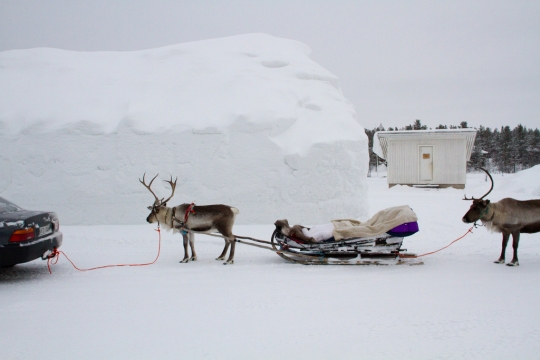
And yes, I did get a chance to take a break so I visited Saariselkä which is near the top of the world
